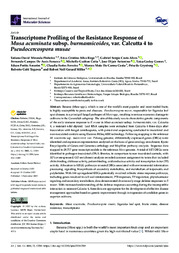Transcriptome profiling of the resistance response of Musa acuminata subsp. burmannicoides, var. Calcutta 4 to Pseudocercospora musae.
Transcriptome profiling of the resistance response of Musa acuminata subsp. burmannicoides, var. Calcutta 4 to Pseudocercospora musae.
Author(s): PINHEIRO, T. D. M.; REGO, E. C. S.; ALVES, G. S. C.; FONSECA, F. C. de A.; COTTA, M. G.; ANTONINO, J. D.; GOMES, T. G.; AMORIM, E. P.; FERREIRA, C. F.; COSTA, M. M. do C.; GRYNBERG, P.; TOGAWA, R. C.; MILLER, R. N. G.
Summary: Banana (Musa spp.), which is one of the world's most popular and most traded fruits, is highly susceptible to pests and diseases. Pseudocercospora musae, responsible for Sigatoka leaf spot disease, is a principal fungal pathogen of Musa spp., resulting in serious economic damage to cultivars in the Cavendish subgroup. The aim of this study was to characterize genetic components of the early immune response to P. musae in Musa acuminata subsp. burmannicoides, var. Calcutta 4, a resistant wild diploid. Leaf RNA samples were extracted from Calcutta 4 three days after inoculation with fungal conidiospores, with paired-end sequencing conducted in inoculated and non-inoculated controls using lllumina HiSeq 4000 technology. Following mapping to the reference M. acuminata ssp. malaccensis var. Pahang genome, differentially expressed genes (DEGs) were identified and expression representation analyzed on the basis of gene ontology enrichment, Kyoto Encyclopedia of Genes and Genomes orthology and MapMan pathway analysis. Sequence data mapped to 29,757 gene transcript models in the reference Musa genome. A total of 1073 DEGs were identified in pathogen-inoculated cDNA libraries, in comparison to non-inoculated controls, with 32% overexpressed. GO enrichment analysis revealed common assignment to terms that included chitin binding, chitinase activity, pattern binding, oxidoreductase activity and transcription factor (TF) activity. Allocation to KEGG pathways revealed DEGs associated with environmental information processing, signaling, biosynthesis of secondary metabolites, and metabolism of terpenoids and polyketides. With 144 up-regulated DEGs potentially involved in biotic stress response pathways, including genes involved in cell wall reinforcement, PTI responses, TF regulation, phytohormone signaling and secondary metabolism, data demonstrated diverse early-stage defense responses to P. musae. With increased understanding of the defense responses occurring during the incompatible interaction in resistant Calcutta 4, these data are appropriate for the development of effective disease management approaches based on genetic improvement through introgression of candidate genes in superior cultivars.
Publication year: 2022
Types of publication: Journal article
Unit: Embrapa Cassava & Fruits
Observation
Some of Embrapa's publications are published as ePub files. To read them, use or download one of the following free software options to your computer or mobile device. Android: Google Play Books; IOS: iBooks; Windows and Linux: Calibre.
Access other publications
Access the Agricultural Research Database (BDPA) to consult Embrapa's full library collection and records.
Visit Embrapa Bookstore to purchase books and other publications sold by Embrapa.

